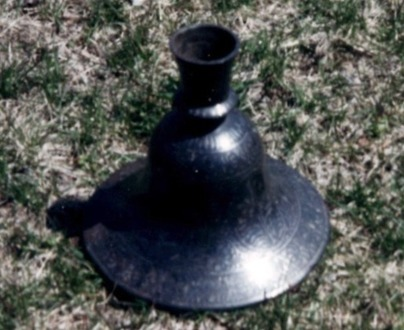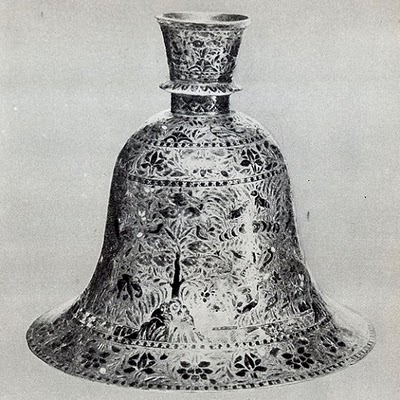|
Today I’d like to call your attention to a fascinating article newly translated into English over at Le site d’Irna on one of fringe history’s most persistent OOPARTs, or “out of place artifacts.” Known as the Dorchester Pot, the small bell-shaped jar was supposedly found buried in an ancient deposit near Dorchester, Massachusetts. This particular piece has been used as evidence for ancient astronauts, Biblical creationism, Hindu creationism, Fortean high strangeness, and numerous other flavors of fringe history. Most readers here will probably know it best from its appearance in Charles Fort’s Book of the Damned in 1919, from which most modern accounts are drawn: There’s a wretch of an ultra-frowsy thing in the Scientific American, 7-298, which we condemn ourselves, if somewhere, because of the oneness of allness, the damned must also be the damning. It’s a newspaper story: that about the first of June, 1851, a powerful blast, near Dorchester, Mass., cast out from a bed of solid rock a bell-shaped vessel of an unknown metal: floral designs inlaid with silver; “art of some cunning workman.” The opinion of the Editor of the Scientific American is that the thing had been made by Tubal Cain, who was the first inhabitant of Dorchester. Though I fear that this is a little arbitrary, I am not disposed to fly rabidly at every scientific opinion. As it happens, Fort didn’t quite get the story right. He got the year wrong for one. In Scientific American for June 5, 1852 (vol. 7, issue 38, p. 298), the magazine quoted a Boston Transcript newspaper report from a few days earlier about the find. That paper in turn threw up its hands and said it had no idea how the jar came to be buried “fifteen feet” below the surface in an ancient rock bed. The paper expressed hope that Prof. Louis Agassiz, the well-known zoologist, botanist, and geologist, could explain it. To this Scientific American added a joke, which Fort seems not to have understood, or purposely misunderstood. The editors joked that “this is not a question of zoology, botany, or geology, but a question relating to an antique metal vessel perhaps made by Tubal Cain, the first inhabitant of Dorchester.” It was a reference to Biblical first blacksmith and a backhanded way of implying that the locals were getting riled up over an unscientific question. This would have been nothing more than one of hundreds of similar stories in the realm of Fortean material were it not for our old friends Louis Pauwels and Jacques Bergier, who, in the midst of looking for ways to collect information to prove that H. P. Lovecraft’s Cthulhu Mythos had some sort of basis in fact, prepared a French translation of Fort by Robert Benayoun. It was published in 1955 with a preface by Bergier. Bergier later used the story of the pot in Extraterrestrial Visitations from Prehistoric Times to the Present (1970). There, Bergier goes beyond Fort (while repeating Fort’s wrong date) and asserts that “the rock that had been dynamited was itself several million years old.” (Incidentally, Bergier helped lay the foundation for David Childress’s Smithsonian conspiracy by asserting on the same page that “the vaults of the Smithsonian Institution in the United States, for example, are full of crates of incomprehensible objects that no one is studying.” He didn’t see this as any different from any other museum, though.) Although Bergier claimed that the object had passed between museums and then disappeared, a piece answering to its name came to the attention of Brad Steiger, the mystery monger, not long after the 1974 English translation of Bergier was published in America, and many years after Steiger first wrote about the bell in 1971’s Atlantis Rising. Steiger published a photograph of the supposed Dorchester Pot in 1978’s Worlds before Our Own, according to the photo credits in a 1982 Reader’s Digest reprint of the photo. (I have not seen Steiger’s original.) The photo is attributed to Milton R. Swanson, discussed anon. Another photo later appeared on the Amazing Massachusetts website. In an Ancient American magazine article from around 2001 (collected in Frank Joseph’s Discovering the Mysteries of Ancient America [2005]), Dennis Ballard said that “recently” a man named Milton R. Swanson of Maine said he owned the object and bought it from a building supervisor for Harvard College who, more or less, stole it from the closet where it had allegedly been kept down to recent years. Ballard was in fact plagiarizing Steiger, and “recently” was the late 1970s. As implausible as this seems, I would like to emphasize a further point that Le site d’Irna did not perhaps emphasize quite enough: the original object found in 1852 was allegedly “in two parts, rent asunder by the explosion,” according to the Transcript, as quoted in Scientific American. Although these parts were put back together to try to understand the object (only after which was its bell shape apparent), the Swanson piece, in the extant photographs of it, betrays no sign of this destruction. I think it is important to quote this exactly because the wording strongly suggests that the original object was not understood to be bell-shaped until its parts were placed back together: “Among [the debris] was picked up a metallic vessel, in two parts, rent asunder by the explosion. On putting the two parts together, it formed a bell-shaped vessel…” So where is the break line? How could metal break so cleanly by explosion (!) that not a trace of the break remains? Later, Reader’s Digest made the piece famous in 1982’s Mysteries of the Unexplained by reproducing the image from Steiger’s book alongside inaccurate text drawn from Fort. Creationists, mostly Christian, picked up the story. In 1993, Michael Cremo and Richard L. Thompson wrote about the same in their Hindu creationist book Forbidden History. The authors reproduce the Scientific American article and add that U.S. Geologic Survey maps state that the rocks around Dorchester were 600 million years old. From here, the object is routinely described as somehow being million years old. According to Steiger, Swanson alleged that Boston’s Museum of Fine Arts spent two years (!) testing the Dorchester Pot but failed to date the object. He claimed that they dated the rock matrix in which it was found to 1,000,000 years ago—and how did they do this, since the pot has no rock on it and its exact location of discovery isn’t known? Oh, and they refused to confirm any of this “for fear of ridicule.” Oddly enough, recent pictures of the object show a different vessel altogether, an Indian pipe holder used on Wikipedia as a comparison for the Swanson photograph and mistaken by some uncritical recent writers for the alleged Dorchester vessel. I won’t belabor the point: All of the pictures of the so-called Dorchester Vessel are pictures of silver hookah bases from nineteenth century water pipes, particularly the kind of Indian-produced hookah equipment popular between 1830 and 1880.
The trouble is that I’m pretty sure that Steiger was taken in by (or even abetted) a fraud, and that the objects passing under the name of the Dorchester Pot are not the specific one found in 1852, for which no pictures were published from 1852 to 1978. These objects show no signs of blasting and no damage consistent with being repaired from two pieces “rent asunder.” Heck, if the piece really had been encased in rock, we should also expect it to have pieces of the rock matrix attached to it—and no one ever claimed that for it, rendering the suggestion that it was ever encased within the rocks all but moot. If I had to guess, I would say that Swanson, or someone who deceived Swanson in making the reported artifact sale, used a pipe holder as the best match for a story he knew only from Fort (or, if my hunch is right, actually Bergier), who in turn had failed to mention that the object had been rebuilt from two pieces. As the author of the Le site d'Irna article told me, it is most likely that the Swanson photograph is actually a copy of a photograph from a late nineteenth or early twentieth century book of Indian art. Really, what are the chances that someone would admit in a public forum to buying a stolen artifact from a Harvard employee and that the school would have made no effort to recover it? What museum would agree to test admittedly stolen goods? If not for Bergier’s claims that the object had been lost from museums, would this story have even been remotely plausible? But, if we take Swanson at his word, someone ought to find whoever has the piece now and confiscate it as stolen property. Sadly, we can’t ask Swanson, since a public records search shows that a man who matches his biographical details died in York, Maine in 2005. I don’t know where the hookah base now rests, but I find it difficult to trust Brad Steiger’s word that it is whatever object was thrown up by blasting in 1852.
12 Comments
Only Me
12/22/2014 09:14:12 am
This shows, once again, how this kind of story grows legs when it's recapitulated by those with a need to prove some form of esoteric knowledge, agenda, etc., is true. It doesn't take much to omit certain key details so the story can be spun into "evidence".
Reply
9/4/2017 02:40:01 pm
Can you state that in a logical, scientific way with evidence? Your comment is proof that atheists with a need to find a reason to dismiss their creator make up vague and unveriafiable claims to do so. Moron, think straight:
Reply
Scott Hamilton
12/22/2014 12:03:23 pm
It would be nice if someone would go through Forbidden Archeology and find out what the deal is with every object they talk about in there. I know that in the fringe-o-sphere the book is highly respected, if only for the sheer number of examples it gives.
Reply
12/22/2014 01:03:25 pm
The Bad Archaeology site went through a number of them, I think. I did a couple at one time, too.
Reply
9/4/2017 02:50:10 pm
Any of you negative-minded geniuses ever typed "biblical archeology" or "creation evidence" or "evidence against the big bang" or evolution into google? No.
SentForth5
12/27/2014 10:44:27 pm
If I wanted to suppress amazing artifactual evidence of ancient civilizations I would set up a site called Bad Archaeology too.
Reply
Only Me
12/27/2014 11:35:12 pm
You haven't actually visited Bad Archaeology, have you?
Reply
SouthCoast
12/30/2014 02:05:50 pm
http://en.wikipedia.org/wiki/Bidriware
Reply
Thanks a lot for your article about this Jason :)
Reply
AncientTech
10/12/2015 09:53:22 pm
You just don't get it, do you? Ancient humans were more advanced, more intelligent, and far more capable than modern man. This is because humans were created perfect, fell, and then have been degenerating ever since. Many out of place artifacts are real and cannot be explained away. Christopher Dunn has proven that the ancients used ultrasonic or some form of very capable hard as diamond machining saws to slice through hard rock like diorite and granite and other materials. We have the solid rock structures fitted together with precision which would require some form of levitation power. And a lot more.
Reply
nali
10/12/2015 10:13:26 pm
You can believe ancient humans were more advanced.
Reply
Your comment will be posted after it is approved.
Leave a Reply. |
AuthorI am an author and researcher focusing on pop culture, science, and history. Bylines: New Republic, Esquire, Slate, etc. There's more about me in the About Jason tab. Newsletters
Enter your email below to subscribe to my newsletter for updates on my latest projects, blog posts, and activities, and subscribe to Culture & Curiosities, my Substack newsletter.
Categories
All
Terms & ConditionsPlease read all applicable terms and conditions before posting a comment on this blog. Posting a comment constitutes your agreement to abide by the terms and conditions linked herein.
Archives
July 2024
|
- Home
- Blog
- Books
-
Articles
-
Newsletter
>
- Television Reviews >
- Book Reviews
- Galleries >
- Videos
-
Collection: Ancient Alien Fraud
>
- Chariots of the Gods at 50
- Secret History of Ancient Astronauts
- Of Atlantis and Aliens
- Aliens and Ancient Texts
- Profiles in Ancient Astronautics >
- Blunders in the Sky
- The Case of the False Quotes
- Alternative Authors' Quote Fraud
- David Childress & the Aliens
- Faking Ancient Art in Uzbekistan
- Intimations of Persecution
- Zecharia Sitchin's World
- Jesus' Alien Ancestors?
- Extraterrestrial Evolution?
- Collection: Skeptic Magazine >
- Collection: Ancient History >
- Collection: The Lovecraft Legacy >
- Collection: UFOs >
- Scholomance: The Devil's School
- Prehistory of Chupacabra
- The Templars, the Holy Grail, & Henry Sinclair
- Magicians of the Gods Review
- The Curse of the Pharaohs
- The Antediluvian Pyramid Myth
- Whitewashing American Prehistory
- James Dean's Cursed Porsche
-
Newsletter
>
-
The Library
-
Ancient Mysteries
>
-
Ancient Texts
>
- Mesopotamian Texts >
-
Egyptian Texts
>
- The Shipwrecked Sailor
- Dream Stela of Thutmose IV
- The Papyrus of Ani
- Classical Accounts of the Pyramids
- Inventory Stela
- Manetho
- Eratosthenes' King List
- The Story of Setna
- Leon of Pella
- Diodorus on Egyptian History
- On Isis and Osiris
- Famine Stela
- Old Egyptian Chronicle
- The Book of Sothis
- Horapollo
- Al-Maqrizi's King List
- Teshub and the Dragon
- Hermetica >
- Hesiod's Theogony
- Periplus of Hanno
- Ctesias' Indica
- Sanchuniathon
- Sima Qian
- Syncellus's Enoch Fragments
- The Book of Enoch
- Slavonic Enoch
- Sepher Yetzirah
- Tacitus' Germania
- De Dea Syria
- Aelian's Various Histories
- Julius Africanus' Chronography
- Eusebius' Chronicle
- Chinese Accounts of Rome
- Ancient Chinese Automaton
- The Orphic Argonautica
- Fragments of Panodorus
- Annianus on the Watchers
- The Watchers and Antediluvian Wisdom
-
Medieval Texts
>
- Medieval Legends of Ancient Egypt >
- The Hunt for Noah's Ark
- Isidore of Seville
- Book of Liang: Fusang
- Agobard on Magonia
- Book of Thousands
- Voyage of Saint Brendan
- Power of Art and of Nature
- Travels of Sir John Mandeville
- Yazidi Revelation and Black Book
- Al-Biruni on the Great Flood
- Voyage of the Zeno Brothers
- The Kensington Runestone (Hoax)
- Islamic Discovery of America
- The Aztec Creation Myth
-
Lost Civilizations
>
-
Atlantis
>
- Plato's Atlantis Dialogues >
- Fragments on Atlantis
- Panchaea: The Other Atlantis
- Eumalos on Atlantis (Hoax)
- Gómara on Atlantis
- Sardinia and Atlantis
- Santorini and Atlantis
- The Mound Builders and Atlantis
- Donnelly's Atlantis
- Atlantis in Morocco
- Atlantis and the Sea Peoples
- W. Scott-Elliot >
- The Lost Atlantis
- Atlantis in Africa
- How I Found Atlantis (Hoax)
- Termier on Atlantis
- The Critias and Minoan Crete
- Rebuttal to Termier
- Further Responses to Termier
- Flinders Petrie on Atlantis
- Amazing New Light (Hoax)
- Lost Cities >
- OOPARTs
- Oronteus Finaeus Antarctica Map
- Caucasians in Panama
- Jefferson's Excavation
- Fictitious Discoveries in America
- Against Diffusionism
- Tunnels Under Peru
- The Parahyba Inscription (Hoax)
- Mound Builders
- Gunung Padang
- Tales of Enchanted Islands
- The 1907 Ancient World Map Hoax
- The 1909 Grand Canyon Hoax
- The Interglacial Period
- Solving Oak Island
-
Atlantis
>
- Religious Conspiracies >
-
Giants in the Earth
>
-
Fossil Origins of Myths
>
- Fossil Teeth and Bones of Elephants
- Fossil Elephants
- Fossil Bones of Teutobochus
- Fossil Mammoths and Giants
- Giants' Bones Dug Out of the Earth
- Fossils and the Supernatural
- Fossils, Myth, and Pseudo-History
- Man During the Stone Age
- Fossil Bones and Giants
- Mastodon, Mammoth, and Man
- American Elephant Myths
- The Mammoth and the Flood
- Fossils and Myth
- Fossil Origin of the Cyclops
- History of Paleontology
- Fragments on Giants
- Manichaean Book of Giants
- Geoffrey on British Giants
- Alfonso X's Hermetic History of Giants
- Boccaccio and the Fossil 'Giant'
- Book of Howth
- Purchas His Pilgrimage
- Edmond Temple's 1827 Giant Investigation
- The Giants of Sardinia
- Giants and the Sons of God
- The Magnetism of Evil
- Tertiary Giants
- Smithsonian Giant Reports
- Early American Giants
- The Giant of Coahuila
- Jewish Encyclopedia on Giants
- Index of Giants
- Newspaper Accounts of Giants
- Lanier's A Book of Giants
-
Fossil Origins of Myths
>
-
Science and History
>
- Halley on Noah's Comet
- The Newport Tower
- Iron: The Stone from Heaven
- Ararat and the Ark
- Pyramid Facts and Fancies
- Argonauts before Homer
- The Deluge
- Crown Prince Rudolf on the Pyramids
- Old Mythology in New Apparel
- Blavatsky on Dinosaurs
- Teddy Roosevelt on Bigfoot
- Devil Worship in France
- Maspero's Review of Akhbar al-zaman
- The Holy Grail as Lucifer's Crown Jewel
- The Mutinous Sea
- The Rock Wall of Rockwall
- Fabulous Zoology
- The Origins of Talos
- Mexican Mythology
- Chinese Pyramids
- Maqrizi's Names of the Pharaohs
-
Extreme History
>
- Roman Empire Hoax
- American Antiquities
- American Cataclysms
- England, the Remnant of Judah
- Historical Chronology of the Mexicans
- Maspero on the Predynastic Sphinx
- Vestiges of the Mayas
- Ragnarok: The Age of Fire and Gravel
- Origins of the Egyptian People
- The Secret Doctrine >
- Phoenicians in America
- The Electric Ark
- Traces of European Influence
- Prince Henry Sinclair
- Pyramid Prophecies
- Templars of Ancient Mexico
- Chronology and the "Riddle of the Sphinx"
- The Faith of Ancient Egypt
- Remarkable Discoveries Within the Sphinx (Hoax)
- Spirit of the Hour in Archaeology
- Book of the Damned
- Great Pyramid As Noah's Ark
- Richard Shaver's Proofs
-
Ancient Texts
>
-
Alien Encounters
>
-
US Government Ancient Astronaut Files
>
- Fortean Society and Columbus
- Inquiry into Shaver and Palmer
- The Skyfort Document
- Whirling Wheels
- Denver Ancient Astronaut Lecture
- Soviet Search for Lemuria
- Visitors from Outer Space
- Unidentified Flying Objects (Abstract)
- "Flying Saucers"? They're a Myth
- UFO Hypothesis Survival Questions
- Air Force Academy UFO Textbook
- The Condon Report on Ancient Astronauts
- Atlantis Discovery Telegrams
- Ancient Astronaut Society Telegram
- Noah's Ark Cables
- The Von Daniken Letter
- CIA Psychic Probe of Ancient Mars
- Scott Wolter Lawsuit
- UFOs in Ancient China
- CIA Report on Noah's Ark
- CIA Noah's Ark Memos
- Congressional Ancient Aliens Testimony
- Ancient Astronaut and Nibiru Email
- Congressional Ancient Mars Hearing
- House UFO Hearing
- Ancient Extraterrestrials >
- A Message from Mars
- Saucer Mystery Solved?
- Orville Wright on UFOs
- Interdimensional Flying Saucers
- Poltergeist UFOs
- Flying Saucers Are Real
- Report on UFOs
-
US Government Ancient Astronaut Files
>
-
The Supernatural
>
- The Devils of Loudun
- Sublime and Beautiful
- Voltaire on Vampires
- Demonology and Witchcraft
- Thaumaturgia
- Bulgarian Vampires
- Religion and Evolution
- Transylvanian Superstitions
- Defining a Zombie
- Dread of the Supernatural
- Vampires
- Werewolves and Vampires and Ghouls
- Science and Fairy Stories
- The Cursed Car
-
Classic Fiction
>
- Lucian's True History
- Some Words with a Mummy
- The Coming Race
- King Solomon's Mines
- An Inhabitant of Carcosa
- The Xipéhuz
- Lot No. 249
- The Novel of the Black Seal
- The Island of Doctor Moreau
- Pharaoh's Curse
- Edison's Conquest of Mars
- The Lost Continent
- Count Magnus
- The Mysterious Stranger
- The Wendigo
- Sredni Vashtar
- The Lost World
- The Red One
- H. P. Lovecraft >
- The Skeptical Poltergeist
- The Corpse on the Grating
- The Second Satellite
- Queen of the Black Coast
- A Martian Odyssey
- Classic Genre Movies
-
Miscellaneous Documents
>
- The Balloon-Hoax
- A Problem in Greek Ethics
- The Migration of Symbols
- The Gospel of Intensity
- De Profundis
- The Life and Death of Crown Prince Rudolf
- The Bathtub Hoax
- Crown Prince Rudolf's Letters
- Position of Viking Women
- Employment of Homosexuals
- James Dean's Scrapbook
- James Dean's Love Letters
- The Amazing James Dean Hoax!
- James Dean, The Human Ashtray
- Free Classic Pseudohistory eBooks
-
Ancient Mysteries
>
- About Jason
- Search
© 2010-2024 Jason Colavito. All rights reserved.







 RSS Feed
RSS Feed
